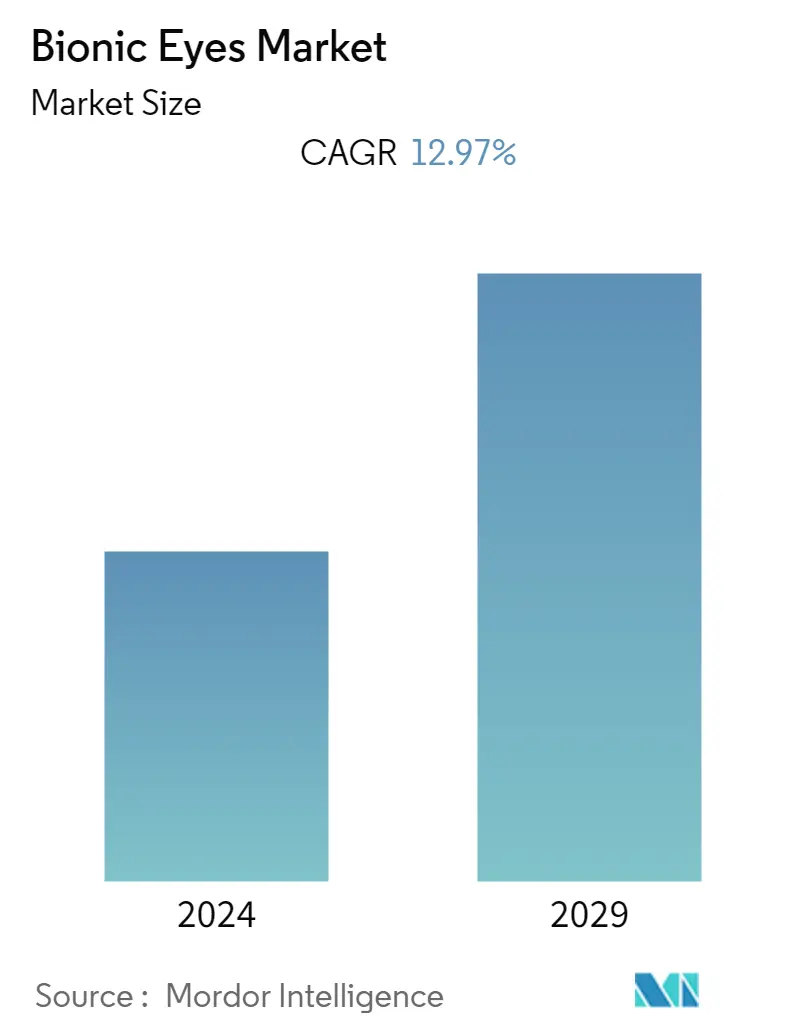Market Size of Bionic Eyes Industry

| Study Period | 2019 - 2029 |
| Base Year For Estimation | 2023 |
| CAGR | 12.97 % |
| Fastest Growing Market | Asia Pacific |
| Largest Market | North America |
| Market Concentration | Medium |
Major Players
*Disclaimer: Major Players sorted in no particular order |
Bionic Eyes Market Analysis
The bionic eyes market is expected to register a CAGR of 12.97% during the forecast period.
The onset of the COVID-19 pandemic had a significant impact on the market studied. During the initial phases of the pandemic, the healthcare system was disrupted, and most of the non-essential treatments were halted. As patients requiring bionic implants were at higher risk of getting infected by COVID-19 during the procedures, following close contact with healthcare professionals, these implant procedures were postponed. This adversely impacted the studied market during the initial phases of the pandemic.
However, the rising burden of issues related to retina and vision loss among chronic COVID-19 infected patients increased the demand for retinal implants, creating opportunities for the market's growth. As per a research study published in the Vision Journal (MDPI) in September 2022, patients with SARS-CoV-2 infection experienced vision loss and impaired visual acuity as an atypical symptom, which needed prompt assessment among the target patients. Hence, such a burden of eye diseases among patients during the pandemic created new opportunities for adopting bionic eyes, driving the market's growth over the analysis period.
Factors such as the growing prevalence of vision loss and other chronic eye diseases, increasing funding by private and public organizations, and rapid advancements in technological developments are expected to fuel the market growth during the analysis period.
The bionic eye implants are still in its infancy, but due to the increasing interest of researchers in the development of innovative products and bringing it to the market for patient care is one of the major factors that drive the growth of the market. For instance, in December 2021, the Phoenix99 bionic eye developed by a team of researchers at the University of Sydney and UNSW was demonstrated to be safe and stable for long-term implantation, and the researchers applied for ethics approval for human trials of the device. The goal of the implantable device was to give people who have severe blindness or vision impairment due to degenerative diseases like retinitis pigmentosa a chance to regain their vision. Hence, the advancements in research and development are predicted to create numerous opportunities for market growth, contributing to the overall market growth during the forecast period.
Furthermore, vision loss and vision impairment has become a major cause of concern across the globe, which creates demand for bionic eyes. For instance, as per data updated by WHO in October 2022, vision impairment and blindness pose a higher financial burden and productivity losses, which are majorly caused by uncorrected refractive errors and cataracts. In addition, vision impairment and blindness can affect people of any age, but it mostly affects people of age 50 years and older. Hence, it is expected to drive the overall market growth in the coming years.
However, the high cost of bionic eyes and lack of awareness among the target population regarding these advanced implants are anticipated to hinder the overall market growth.
Bionic Eyes Industry Segmentation
As per the scope of the report, retinal prostheses, also known as bionic eye, are retinal implants used as visual prostheses to improve the vision of people with vision loss, vision impairment, and other chronic eye diseases. The Bionic Eye Market is segmented by Type (External Eye and Implanted Eye), Technology (Mechanical and Electronic), Indication (Vision Loss and Impairment, Dry Age-related Macular Degeneration (dry AMD), and Others), End User (Hospitals, Ophthalmic Clinics, and Others (Ambulatory Care Centers), and Geography (North America, Europe, Asia-Pacific, Middle East and Africa, and South America). The market report also covers the estimated market sizes and trends for 17 countries across major regions globally. The report offers the value (in USD million) for the above segments.
| By Type | |
| External Eye | |
| Implanted Eye |
| By Technology | |
| Mechanical | |
| Electronic |
| By Indication | |
| Vision Loss and Impairment | |
| Dry Age-related Macular Degeneration (dry AMD) | |
| Others |
| By End User | |
| Hospitals | |
| Ophthalmic Clinics | |
| Others |
| Geography | ||||||||
| ||||||||
| ||||||||
| ||||||||
| ||||||||
|
Bionic Eyes Market Size Summary
The bionic eyes market is poised for significant growth, driven by advancements in technology and increasing awareness of vision loss issues globally. The market experienced initial setbacks due to the COVID-19 pandemic, which disrupted healthcare services and delayed non-essential procedures, including bionic eye implants. However, the pandemic also highlighted the need for retinal implants among patients experiencing vision loss as a result of COVID-19, creating new opportunities for market expansion. The growing prevalence of chronic eye diseases, coupled with increased funding from both private and public sectors, is expected to further propel the market. Research and development efforts, such as the development of the Phoenix99 bionic eye, are paving the way for innovative products that promise to restore vision for those with severe blindness due to degenerative conditions.
The implanted bionic eye segment is anticipated to witness considerable growth, supported by ongoing research and technological advancements. Products like the Argus II Retinal Prosthesis System, the first FDA-approved prosthetic retina implant, exemplify the innovative solutions driving market growth. North America is expected to hold a significant market share, attributed to the high prevalence of chronic diseases and the aging population, which increases the demand for vision restoration solutions. The rising incidence of diabetic retinopathy further underscores the need for bionic eyes in the region. Despite the high cost and limited awareness of these advanced implants, the market remains competitive, with key players like Vivani Medical, Inc., and Pixium Vision S.A. actively engaging in research and innovation to introduce new products.
Bionic Eyes Market Size - Table of Contents
-
1. MARKET DYNAMICS
-
1.1 Market Overview
-
1.2 Industry Attractiveness - Porter's Five Forces Analysis
-
1.2.1 Bargaining Power of Suppliers
-
1.2.2 Bargaining Power of Consumers
-
1.2.3 Threat of New Entrants
-
1.2.4 Threat of Substitute Products
-
1.2.5 Intensity of Competitive Rivalry
-
-
1.3 Market Drivers
-
1.3.1 Growing Prevalence of Vision Loss and Other Chronic Eye Diseases
-
1.3.2 Increasing Funding by Private and Public Organizations
-
1.3.3 Rapid Advancements in Technological Developments
-
-
1.4 Market Restraints
-
1.4.1 High Research and Development Costs
-
1.4.2 Low Awareness Among Target Population Regarding Available Products
-
-
-
2. MARKET SEGMENTATION (Market Size by Value - USD million)
-
2.1 By Type
-
2.1.1 External Eye
-
2.1.2 Implanted Eye
-
-
2.2 By Technology
-
2.2.1 Mechanical
-
2.2.2 Electronic
-
-
2.3 By Indication
-
2.3.1 Vision Loss and Impairment
-
2.3.2 Dry Age-related Macular Degeneration (dry AMD)
-
2.3.3 Others
-
-
2.4 By End User
-
2.4.1 Hospitals
-
2.4.2 Ophthalmic Clinics
-
2.4.3 Others
-
-
2.5 Geography
-
2.5.1 North America
-
2.5.1.1 United States
-
2.5.1.2 Canada
-
2.5.1.3 Mexico
-
-
2.5.2 Europe
-
2.5.2.1 United Kingdom
-
2.5.2.2 France
-
2.5.2.3 Germany
-
2.5.2.4 Italy
-
2.5.2.5 Spain
-
2.5.2.6 Rest of Europe
-
-
2.5.3 Asia-Pacific
-
2.5.3.1 India
-
2.5.3.2 China
-
2.5.3.3 Japan
-
2.5.3.4 Australia
-
2.5.3.5 South Korea
-
2.5.3.6 Rest of Asia-Pacific
-
-
2.5.4 Middle East and Africa
-
2.5.4.1 GCC
-
2.5.4.2 South Africa
-
2.5.4.3 Rest of Middle East and Africa
-
-
2.5.5 South America
-
2.5.5.1 Brazil
-
2.5.5.2 Argentina
-
2.5.5.3 Rest of South America
-
-
-
Bionic Eyes Market Size FAQs
What is the current Bionic Eyes Market size?
The Bionic Eyes Market is projected to register a CAGR of 12.97% during the forecast period (2024-2029)
Who are the key players in Bionic Eyes Market?
Pixium Vision S.A., Optobionics Corporation, Bionic Vision Technologies, iBionics and Vivani Medical, Inc. are the major companies operating in the Bionic Eyes Market.

